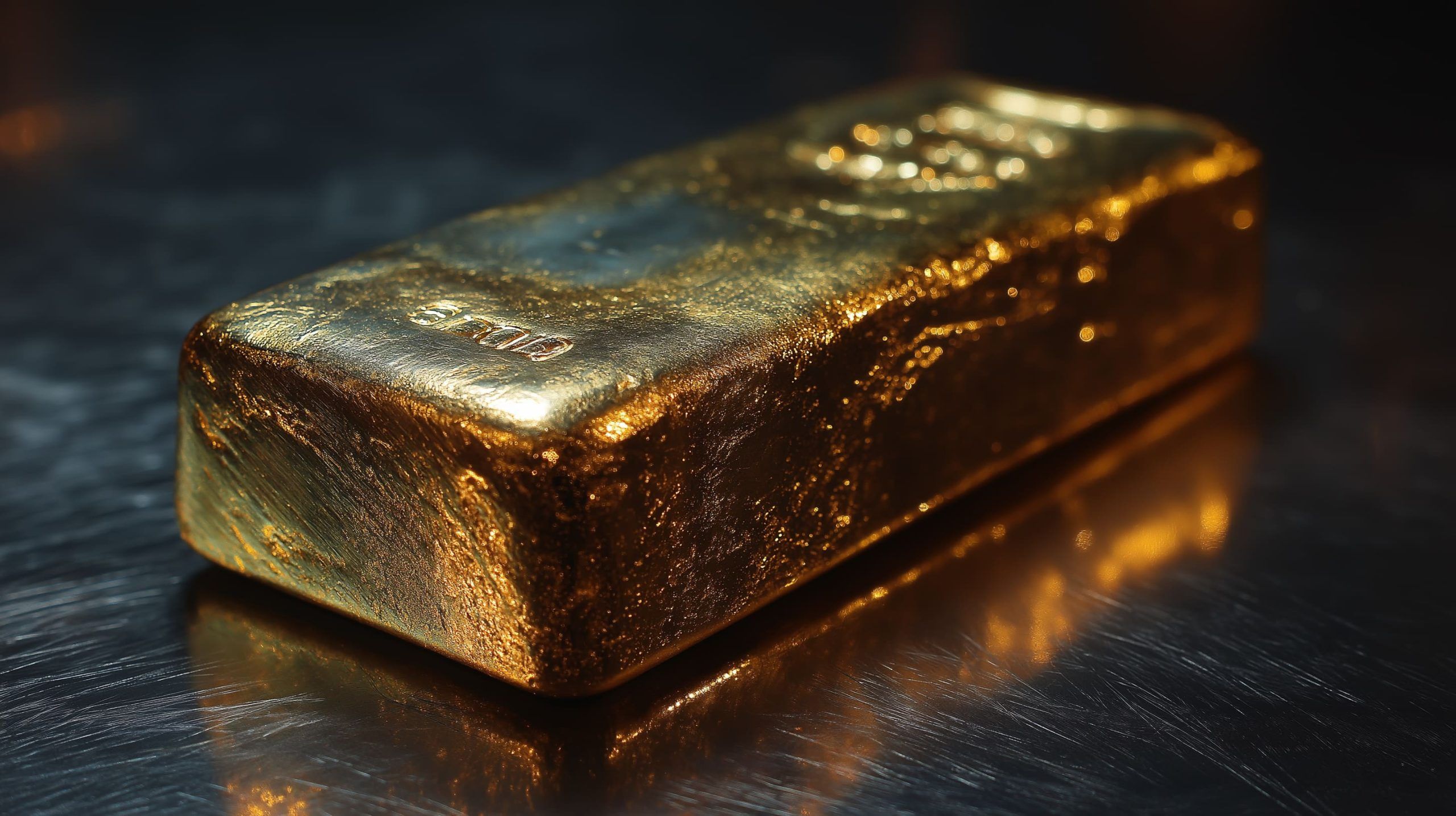Key Facts – October 18, 2025
- Record Highs: Gold prices surged to an all-time high above $4,300 per ounce this week, then pulled back to around $4,210 by the end of Friday, October 17 [1]. The metal still notched a ~4.8% weekly gain after briefly touching $4,378/oz – its highest price ever [2].
- Massive 2025 Rally: Gold is up over 60% year-to-date, far outpacing major stock indexes and even cryptocurrencies [3]. This marks one of gold’s biggest annual rallies in half a century, raising questions about how much higher it can climb.
- Safe-Haven Demand: Investors have flocked to gold as a safe haven amid economic uncertainty. Key drivers include bets on U.S. interest rate cuts, persistent inflation, and global tensions. Brewing U.S.-China trade conflicts and a protracted U.S. government shutdown fueled the flight to safety, while expectations of Federal Reserve rate reductions supercharged the gold rush [4].
- Fed Policy Boost: Markets are pricing in a 0.25% Fed rate cut at the late-October meeting and another in December, with probabilities over 95% [5]. Lower rates reduce bond yields and the dollar’s appeal, which supports non-yielding gold as an alternative store of value.
- Silver Soars Too: Gold’s rise has lifted other precious metals. Silver hit a record high near $54 per ounce, its highest level in decades, before settling around $51 [6]. Platinum and palladium also jumped to multi-year highs during the frenzy.
- Mixed Outlooks: Some analysts warn the rally may be peaking in a “blow-off top.” They foresee a near-term correction toward ~$3,500/oz for gold after its parabolic surge [7]. However, many others remain bullish – several banks now predict gold prices “north of $5,000” in the next year or two [8], citing supportive fundamentals and sustained demand.
Gold Hits Historic Highs in October
Gold’s price explosion in 2025 reached a climax this week. On Thursday, October 16, spot gold soared past $4,300/oz for the first time ever [9]. By early Friday, it had spiked to an intraday record of about $4,378.69. This historic rally has been rapid – gold entered the year around $2,800 and has since nearly doubled, repeatedly smashing records in recent days. As of October 18, 2025, gold is hovering near $4,210/oz, cooling slightly after its meteoric rise [10].
The late-week pullback came after a comment from U.S. President Donald Trump eased some trade war jitters. Trump indicated a proposed 100% tariff on Chinese goods was “not sustainable,” striking a more conciliatory tone on the U.S.-China dispute [11]. The prospect of de-escalation strengthened the U.S. dollar and prompted some profit-taking in precious metals. Gold fell over 2% on Friday after Trump’s remarks, which “took a little heat out of the precious trade,” noted independent metals trader Tai Wong [12]. Even with that dip, the metal posted one of its best weeks in years – up nearly 5% – and remains about 64% higher than at the start of 2025 [13]. By comparison, Wall Street’s S&P 500 stock index is only modestly higher for the year, and gold’s performance has eclipsed even red-hot crypto markets [14].
Analysts call this gold’s biggest rally in half a century, rivaling the inflation-driven surges of the 1970s [15]. “Momentum in gold has been unrelenting,” observed researchers at LPL Financial, who noted the metal has seen roughly three up-days for every down-day since late summer [16]. Each time gold prices have briefly pulled back, eager buyers have jumped back in, viewing any dip as another buying opportunity. This dynamic has kept gold in a steep uptrend, setting the stage for the dramatic records logged this week.
Why Are Gold Prices Soaring?
Multiple forces have converged to drive gold’s breathtaking rise. Macroeconomic uncertainty and shifting Federal Reserve policy are at the heart of the rally. With U.S. inflation still running above target and economic signals turning mixed, investors increasingly expect the Fed to cut interest rates in the coming months to support growth [17]. In fact, futures markets put near-certain odds on a quarter-point rate cut at the Fed’s meeting later this month (October), and another cut by December [18]. These dovish expectations are crucial because lower interest rates make gold more attractive – the metal carries no yield, so when bond yields fall, gold’s opportunity cost decreases. Moreover, rate cuts tend to weaken the dollar, and a softer dollar boosts dollar-priced gold by making it cheaper for overseas buyers.
Safe-haven demand has also been a major catalyst. Investors seek out gold in times of turmoil, and lately there’s been no shortage of potential crises. The U.S. government was partially shut down for weeks through mid-October due to budget gridlock, delaying economic data releases and underscoring political dysfunction [19]. Simultaneously, U.S.-China trade tensions flared up: Washington criticized Beijing’s export curbs on critical minerals, and China warned of retaliation, raising fears of a renewed trade war. “Brewing U.S.-China trade tensions and the U.S. government shutdown” have together sent investors rushing into safe-haven gold, Reuters noted in its market commentary [20]. Each of these uncertainties has added a layer of risk aversion in financial markets – and gold is one of the primary assets investors turn to for shelter in such times.
Geopolitical conflicts abroad further stoked the flight to safety. In the Middle East, earlier this month a conflict in Gaza prompted worries of wider instability, while in Europe the ongoing war in Ukraine kept investors on edge. There was a glimmer of relief late this week – a cease-fire in the Israel-Hamas conflict and news of a planned summit between President Trump and Russia’s President Putin to discuss ending the Ukraine war offered hope that some global risks might be easing [21] [22]. Those developments have actually weighed on oil prices (more on that below) and could have tempered gold’s rise. However, overall geopolitical volatility remains high, and that undercurrent continues to underpin demand for precious metals [23]. As one example, fresh U.S.-China friction or any setback in the tentative peace efforts could quickly reignite safe-haven flows.
Beyond these headline drivers, fundamental supply-demand dynamics are bolstering gold. Central banks around the world are voraciously buying gold for their reserves – nations like China, India, and Turkey have been increasing gold holdings to diversify away from the U.S. dollar. This year central banks’ gold purchases are on track to hit the highest level since 2011 [24]. Private investors have joined in via exchange-traded funds (ETFs): gold-backed ETFs have seen record inflows in recent months, as portfolio managers allocate more money to bullion amid shaky equity markets and a weakening dollar [25]. “Gold, a traditional hedge against uncertainty, has surged… driven by geopolitical tensions, central bank buying, a switch out of the dollar, and strong inflows into gold exchange-traded funds,” Reuters summarized [26]. In other words, the demand for gold has been coming from all sides – institutional and retail, defensive and speculative – creating a perfect storm for prices.
Stocks, Oil, Crypto: How Other Assets Compare
Gold’s stunning climb this year has left most other asset classes in the dust. By mid-October, gold’s ~60% year-to-date gain dwarfs the performance of major stock indices and bonds [27]. The U.S. stock market, for instance, has had a solid 2025 driven by tech-sector strength, but the S&P 500 is up only on the order of tens of percent, not multiples. (The S&P and Nasdaq actually hit their own record highs earlier in October, but have since seesawed amid earnings season and macro jitters.) In contrast, gold’s nearly two-thirds jump in value marks an extraordinary run-up rarely seen in such a widely-held asset.
Even the cryptocurrency boom of 2025 has been outshone by gold’s rally in absolute terms. Bitcoin – often dubbed “digital gold” – has enjoyed a bull run this year alongside other alternative assets. In fact, Bitcoin recently breached $125,000 for the first time ever [28], roughly doubling in price from a year ago. However, that ~100% annual gain still lags behind gold’s performance in 2025. As of this week, Bitcoin pulled back slightly to just under $122K [29], and other major crypto tokens have likewise cooled after strong advances. While crypto and gold both benefit from a debasement trade narrative (investors hedging against currency debasement and inflation), gold’s lower volatility and longer track record have attracted a broader base of safe-haven seekers this year. “Gold prices have risen more than 60% since the start of the year, far outpacing the performance of major stock indexes and cryptocurrencies,” Investopedia noted [30].
Oil prices, meanwhile, have moved in the opposite direction of gold lately. Crude oil had spiked earlier in 2025 due to supply cuts and war fears, but by mid-October it has slumped on signs of ample supply and easing conflict risk. On Friday the 17th, Brent crude settled around $61.29 per barrel and U.S. WTI crude near $57.54, marking a nearly 3% weekly decline [31]. A big factor has been a growing consensus that the oil market could see a glut in coming months – the International Energy Agency (IEA) forecast surplus supply, and U.S. crude inventories jumped to multi-year highs [32] [33]. At the same time, the cease-fire in the Middle East and the prospect of peace talks in Ukraine have removed some of the geopolitical risk premium that was propping up oil prices [34] [35]. Additionally, cooling economic demand is a worry: escalating U.S.-China trade disputes are “adding to concerns about an economic slowdown and lower energy demand,” analysts note [36]. In short, many of the forces that lift gold (economic uncertainty, trade tensions) are actually dragging oil down, since a weaker economy means less consumption of fuel. This divergence highlights how unique gold’s role is – it thrives on turmoil that can hurt other commodities.
Finally, the U.S. dollar itself has seen mixed moves. Earlier in the year the dollar weakened, aiding gold’s ascent. Lately, with the Fed on the cusp of easing, the dollar index has hovered at 15-year lows around the mid-90s. However, during the risk-off episodes in October, the dollar firmed slightly as a short-term haven (up about 0.1% on Friday) [37]. Yet gold and the dollar have been rising in tandem on occasion – a rare occurrence – reflecting the extraordinary demand for safety in any form. Investors have essentially been hedging bets by holding both cash and gold. “These moves show a market rotating (at least temporarily) toward safety,” one market report observed, noting that surging gold signals investors hedging against uncertainty across the board [38].
Will Gold Keep Climbing? Forecasts and Expert Views
With gold at record highs, the big question is what comes next. Opinions are split between those who believe the rally has more room to run and those urging caution that a correction is looming.
On the bullish side, a chorus of market experts and institutions now predict gold will extend its gains. Investment banks have been raising their gold price targets repeatedly in recent months – often only to see gold blast through those targets even faster than expected. For example, Goldman Sachs in late September projected gold would reach $4,300 by year-end, but that milestone was achieved by mid-October. Goldman has since hiked its forecast, now seeing gold at $4,900 by the end of 2025 [39]. Similarly, Bank of America and UBS are looking further out and growing more bullish: HSBC now expects gold to hit $5,000 in 2026 [40], and Bank of America projects a peak as high as $6,000 per ounce by spring 2026 [41]. “Wall Street forecasts have soared,” notes financial news site TechStock², which reports that Bank of America raised its 2026 gold target to $5,000, Societe Generale sees gold near $5,000 by late 2026, and Standard Chartered Bank pegs next year’s average around $4,488 [42] [43]. These institutions cite many of the same themes driving gold now – persistent inflation, dovish monetary policy, and strong physical demand – continuing to provide support in the medium term.
Many analysts argue that structural factors could keep gold in an uptrend. “Gold’s trajectory will hinge on the rate-cut picture heading into 2026 as well as developments around U.S.-China,” said Zain Vawda, an analyst with OANDA. If no deal is reached and the U.S.-China relationship continues to deteriorate, “that could be the spark gold needs to cross the $5,000/oz barrier,” Vawda noted [44]. Phillip Streible, chief market strategist at Blue Line Futures, is another bull: “Gold could easily continue its upward momentum… We could see prices north of $5,000 by the end of 2026,” Streible predicts [45] [46]. He points to steady central bank buying, firm ETF inflows, trade tensions, and the prospect of lower U.S. interest rates as a potent combination that will likely keep a floor under gold prices [47]. In essence, the pro-gold camp believes that even if we get a pause or pullback, the macro backdrop (high debt levels, geopolitical rivalries, and a likely shift to easier monetary policy) will drive gold to new heights in the coming years.
However, there is a cautious camp warning that gold’s rocket ride may soon hit turbulence. After such a steep ascent, the risk of a correction looms large. Some technical analysts see signs of a “blow-off top” – a final euphoric surge before a downturn. They draw parallels to past market cycles: for instance, in 2006 gold had a similar 36% two-month spike followed by a sharp 20-25% drop [48] [49]. “Analysts warn that gold, silver, and platinum may soon face corrections similar to those seen in past bull market cycles,” reported The Economic Times (India) [50]. The current price action has pushed gold far above long-term trendlines, and overbought indicators are flashing. Gandharv Walia, a commodities analyst at ET, notes that technical signals point to an imminent peak between ~$4,400 and $4,600, to be followed by a fall back toward ~$3,500/oz in the short term [51] [52]. Likewise, HSBC – despite its longer-term optimism – has cautioned that gold’s remarkable run could pause. The bank raised its 2025 average gold price forecast to $3,455 (up $100 from prior) and acknowledged the likelihood of some consolidation before the uptrend resumes [53]. “A near-term correction would be healthier for a longer-term uptrend,” agrees Suki Cooper, head of commodities research at Standard Chartered, who still believes “this rally has legs” beyond any short-term pullback [54] [55].
Ultimately, the outlook for gold will hinge on how reality matches these expectations. In the short run, traders are watching closely for the Federal Reserve’s next moves and any resolution in Washington’s fiscal standoff. If the Fed indeed cuts rates as anticipated in late October, it could inject fresh fuel into gold’s rally – or, conversely, if the Fed surprises with a more cautious stance, gold might see a bout of profit-taking. Geopolitical headlines will also be key: progress toward peace in major conflicts could dampen safe-haven flows, whereas any escalation would do the opposite.
For now, gold investors are enjoying the ride. The metal’s enduring appeal as a store of value has shone bright in 2025’s volatile climate. Gold’s strong finish this week at over $4,200/oz [56] signals that plenty of buyers are still out there on every dip. Whether the next stop is a healthy correction or another leg higher toward $5,000+, the precious metal has firmly reasserted itself as a focal point of global markets. As one strategist put it, “It certainly feels like momentum is on gold’s side” – and many are betting that any near-term setbacks will be just a stepping stone in gold’s journey to new heights [57] [58].
Sources: Gold market analysis and price data from Reuters [59] [60] [61] [62]; expert commentary from Reuters, Investopedia, Economic Times, and TechStock² [63] [64] [65] [66] [67]; oil and stock market context from Reuters [68] [69]; cryptocurrency price from TechStock²/Investopedia [70]. All information is up to date as of October 18, 2025.
References
1. www.reuters.com, 2. www.reuters.com, 3. www.investopedia.com, 4. www.reuters.com, 5. www.reuters.com, 6. www.reuters.com, 7. economictimes.indiatimes.com, 8. ts2.tech, 9. www.reuters.com, 10. www.reuters.com, 11. www.reuters.com, 12. www.reuters.com, 13. www.reuters.com, 14. www.investopedia.com, 15. www.investopedia.com, 16. www.investopedia.com, 17. www.reuters.com, 18. www.reuters.com, 19. ts2.tech, 20. www.reuters.com, 21. www.reuters.com, 22. www.reuters.com, 23. ts2.tech, 24. www.investopedia.com, 25. ts2.tech, 26. www.reuters.com, 27. www.investopedia.com, 28. ts2.tech, 29. ts2.tech, 30. www.investopedia.com, 31. www.reuters.com, 32. www.reuters.com, 33. www.reuters.com, 34. www.reuters.com, 35. www.reuters.com, 36. www.reuters.com, 37. www.reuters.com, 38. ts2.tech, 39. www.investopedia.com, 40. www.investopedia.com, 41. www.investopedia.com, 42. ts2.tech, 43. ts2.tech, 44. www.reuters.com, 45. ts2.tech, 46. ts2.tech, 47. ts2.tech, 48. economictimes.indiatimes.com, 49. economictimes.indiatimes.com, 50. economictimes.indiatimes.com, 51. economictimes.indiatimes.com, 52. economictimes.indiatimes.com, 53. www.reuters.com, 54. ts2.tech, 55. ts2.tech, 56. www.reuters.com, 57. ts2.tech, 58. www.reuters.com, 59. www.reuters.com, 60. www.reuters.com, 61. www.reuters.com, 62. www.reuters.com, 63. www.reuters.com, 64. www.reuters.com, 65. www.investopedia.com, 66. economictimes.indiatimes.com, 67. ts2.tech, 68. www.reuters.com, 69. www.reuters.com, 70. ts2.tech







